Northam Warren
Northam Warren was one of five children born to Leroy Warren and Fannie Louise Warren (née Wadsworth). He grew up in Grand Rapids, Michigan but after the family moved to Lawrence, Kansas, he attended the University of Kansas. There he studied to be a chemist, before graduating from a business course at the University of Chicago.
His first employment was with Parke-Davis, a large pharmaceutical manufacturer, then known as Parke, Davis & Co. Starting as a secretary for William M. Warren [1864-1903] he then worked in various capacities in assorted departments within the organisation. Parke-Davis introduced Northam to the drug business and he furthered this knowledge in this area by taking night courses at the Detroit College of Pharmacy and by clerking part-time in drug stores to learn the retail side of the trade (Kane, 1946, p. 43).
In 1907, Northam Warren moved to New York to work in the drug import and export department of Parke, Davis & Co. but, in 1910, decided to go into business for himself as a drug and chemical broker, starting the business with finance provided by his wife, Edna Louise O’Brien [1882-1960]. Then, in 1911, he started a sideline to his brokerage business, a liquid cuticle remover he trademarked as ‘Cutex’.
The Cutex Cuticle Remover was not the only product Northam Warren released around this time. In 1913, he filed a trademark for ‘Phoebe Snow’ for a brand of talcum powder. The name had been previously used in advertisements for the Lackawanna Railroad that connected Buffalo, New York, and Hoboken so Northam Warren may have selected it to take advantage of its widespread recognition.
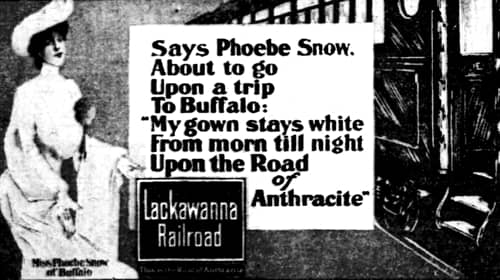
Above: (Lackawanna Railroad advertisement, 1904)
After the Cutex Cuticle Remover proved to be successful, Northam Warren lost interest in Phoebe Snow and he began to add other nail-care products to Cutex, gradually building up a complete manicure line.
See also: Cutex
Northam Warren Corporation
Initially, Cutex was sold though Northam Warren’s Special Products Company that operated out of one small room at 9 West Broadway, New York but, in 1915, Northam Warren secured the financial basis for his growing Cutex business by establishing the Northam Warren Corporation in New York with a capital of US$85,000. The following year he decided to get professional help to promote Cutex across the United States and engaged the J. Walter Thompson agency to develop an extensive national advertising campaign.
J. Walter Thompson (JWT) was a well-established firm founded in 1877 by James Walter Thompson [1847-1928]. It had advertising accounts with a number of toilet goods companies including Pond’s from 1886, Woodbury from 1910, and Odorono from 1914. The campaign it developed for Cutex was designed by Helen Lansdowne Resor [1886-1964], one of J. Walter Thompson’s chief copywriters. It proved to be very successful and the Cutex brand continued to expand.
Expansion
In 1918, two years after the J. Walter Thompson advertising campaign had begun, the rising volume of business forced Northam Warren to move from West Broadway to larger quarters at 114-118 West 17th Street, New York and the company eventually bought the six-storey property there from James N. Jarvie in 1925. Three years later, in 1928, there was another move to even larger quarters at 191 Hudson Street, New York.
As well as growing within the United States, Northam Warren began expanding into other countries. Starting with Canada, Northam Warren continued into England, Europe and South America and then, in the ensuing years, to Asia and Africa giving the company a global reach.
The company also continued to add new products to its Cutex range, most notably Cutex Nail Polish in 1916. During the 1920s this liquid nail polish went on to become the most important item in the Cutex product range and, by 1930, was the largest selling nail polish within the United States and around the world.
Acquisitions
Northam Warren used the profits he made from Cutex to fund a number of acquisitions, starting with shares in Van Dyke & Co., Inc., which presumably manufactured the dyes used in Cutex preparations. Northam Warren also bought Dr. J. Parker Pray Products, a well-established New York company that made a range of nail and other toilet preparations. Then, in 1926, Northam Warren acquired Elcaya Co. Inc., another New York company most noted for its Crême Elcaya Toilet Cream.
See also: Elcaya
In 1928, Northam Warren then purchased The Odorono Company, which made antiperspirants, deodorants and depilatories, and The Glazo Company, which also sold a liquid nail polish, both companies owned by Mrs. Edna Albert [1887-1969] of Cincinnati.
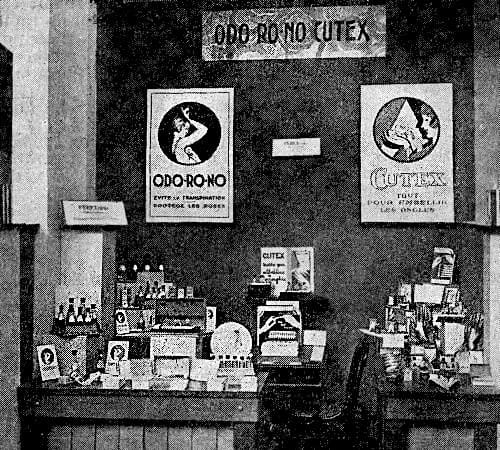
Above: 1931 Cutex and Odorono at a trade show in Paris.
In 1930, Northam Warren acquired a substantial interest in Peggy Sage, New York, a prestigious brand selling nail polishes and other cosmetics through department stores and Peggy Sage manicure salons.
See also: Peggy Sage
These acquisitions increased Northam Warren’s domination of all levels of the nail polish market. Peggy Sage was a prestige brand while Glazo occupied a middle position generally selling in drug store chains and in retailers that were just below the prestige establishments. Cutex, the dominant brand in 1930, sold across all sectors of the market but sales in the United States were beginning to come mainly from what were referred to as syndicated, variety or ‘five-and-dime’ stores (Nail enamel, 1959, p. 458). The differentiation between the three brands can be partly seen in their pricing. In 1935, Cutex’s liquid polish was selling for US35¢, Glazo’s could be bought in one of two sizes at US35¢ and US50¢, and Peggy Sage was retailing for US$1.00. Cutex had lower margins but it was more profitable than the other two ranges due to its large sales. Unfortunately for Northam Warren, its sales would be affected by the arrival of new 1930s entrants in the nail polish market like Chen Yu and Dura Gloss with Revlon being the most aggressive.
Revlon
The Revlon Nail Enamel Company was founded in 1932 by Charles Revson [1906-1975], Joseph Revson [1905-1971] and Charles Lachman [1897-1978]. Its arrival would prove to be the beginning of the end of Northam Warren’s commanding position both in the United States and overseas.
Revlon retailed its nail enamel at US60¢. The higher price helped establish Revlon as a prestige brand and the extra margin enabled Revlon to fund the expensive magazine advertisements that helped it become the dominant player in the American nail polish market.
Revlon took advantage of the 1930s fashion vogue which required nail polish to be matched with lipsticks. This trend saw the replacement of transparent nail polishes made with dyes, with cream (opaque) types made with pigments. As pigments were also used in lipsticks, cream nail polish shades were easier to match with lipstick shades.
All Revlon polishes were of the cream type. Northam Warren did not introduce them into the Cutex line until 1934, two years after Revlon produced its first nail polish.
See also: Nail Polishes/Enamels
In 1935, Northam Warren added lipsticks to the Cutex range. They came in shades matched to some Cutex nail polishes and were promoted using the slogan “Fashion says—Lips and fingertips now must match”. In 1939, Revlon introduced its own range of lipsticks in shades matched to Revlon nail enamels. These were promoted using the slogan “Matching fingertips and lips”, a reversal of the one used by Cutex. Like its nail enamels, Revlon also sold its lipsticks at a higher price than those retailed by Cutex.
See also: Revlon
Pressure from Revlon may have been partly responsible for Northam Warren disposing of some of its assets. In 1938, Elcaya and Glazo were to Louis W. Halk [1882-1939], a previous vice-president of Northam Warren.
Wartime
Northam Warren made a number of contributions to the war effort. It made electrical connectors for aircraft and it was the sole supplier of these parts to the United States Air Force. In 1940, the company moved its corporate and manufacturing headquarters to a new plant in Stamford, Connecticut that it had completed in 1939 and the aircraft parts were made there for the duration of the war.
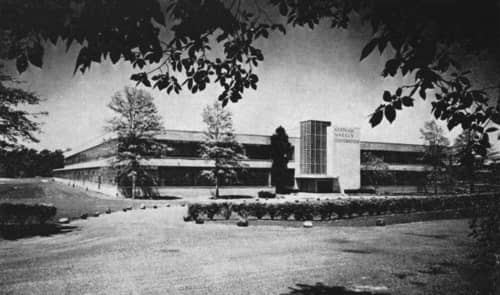
Above: 1960 Northam Warren facilities in Stamford, Connecticut.
It was at this time that Northam Warren Jr. [1914-2002] started working with the company.
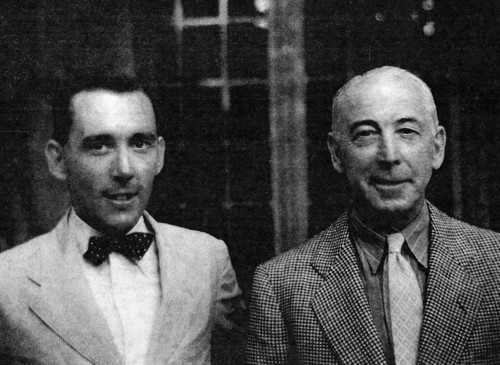
Above: Northam Warren Jr. and Northam Warren Snr. The younger Northam Warren started working for Northam Warren when the new plant opened in Stamford and then returned to the company after serving in the field artillery during the Second World War. He was the public face of Northam Warren in the post-war period and promoted the company at cosmetic conventions.
Northam Warren also produced materials for the Canadian government, chiefly anodising airplane parts, especially propellors (Kane, 1946, p. 44) and produced Sniff Kits to help train personnel in the smell of dangerous chemicals.
Post-war
Northam Warren continued to lose ground after the war due to increased competition. Odorono suffered from new entrants with novel delivery systems and/or improved formulations such as Stopette (Jules Montenier, 1947), Ban (Bristol-Myers, 1955) and Right Guard (Gilette, 1960). Rather than being a market leader, Northam Warren found itself playing catch-up with these new innovations, its one attempt at producing a new delivery system, Odo-ro-no Satin Sponge (1958), being a market failure.
See also: Deodorants and Antiperspirants
Lipsticks and nail polishes sales by Cutex and Peggy Sage also suffered. During the American ‘Lipstick Wars’ of the 1950s companies like Revlon, Coty, and Hazel Bishop spent large somes of money promoting their products through the costly medium of television making it increasingly difficult for other players to compete.
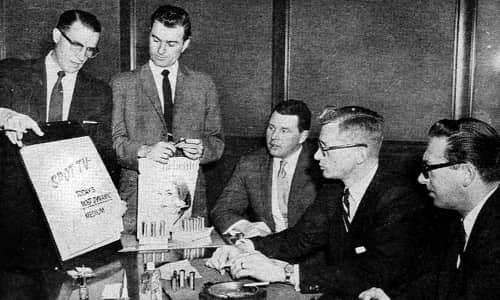
Above: 1959 National Broadcasting Company (NBC) executives promoting spot television sales to Northam Warren executives and members of the Doyle Dane Bernbach advertising agency who held the Northam Warren account at the time.
See also: Lipstick Wars
Northam Warren was also disadvantaged by having little or no presence in the youth market, hair-care products like home permanents and hair dyes, or eye make-up, all major growth areas in the post-war period when sales on nail polish began to decline. The company looked into creating a home permanent but it came to nothing. It is worth noting that one of the first things that Chesebrough-Pond’s did after it purchased Northam Warren was to add an eye make-up range to Cutex.
Chesebrough-Pond’s
Northam Warren was sold to Chesebrough-Pond’s on December 30, 1960 with Northam Warren Jr., staying on in a management role with the new owners. The price was not disclosed but it was believed to have been around US$10m. Northam Warren Snr. died shortly afterwards in 1962.
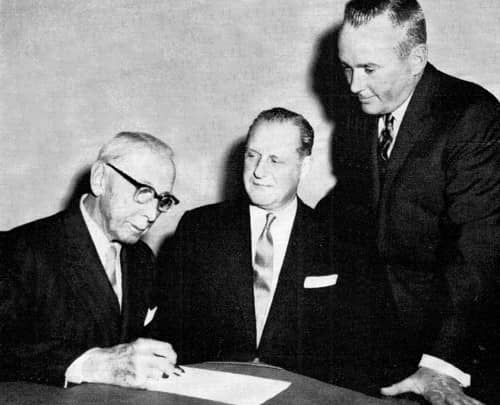
Above: 1961 Northam Warren, Sr (left), Jerome A. Straka [1903-1986], president of Chesebrough-Pond’s (centre) and Northam Warren, Jr (right) at the announcement of the sale of Northam Warren to Chesebrough-Pond’s.
Although its roots extended back to 1849, Chesebrough-Pond’s was a relatively new entity in 1960, formed from the merger of the Chesebrough Manufacturing Company and the Pond’s Extract Company in 1955. It was looking to expand and Northam Warren was not its first acquisition. Like Northam Warren they sold products chiefly through drug and variety stores in the lower end of the cosmetic retail market so the purchase appeared to be a good fit. However, neither they nor Unilever – who acquired Chesebrough-Pond’s in 1986 – was able to return any of the Northam Warren brands to their former glory.
See also: Chesebrough-Pond’s
Timeline
| 1911 | Northam Warren Company founded by Northam Warren. |
| 1911 | Northam Warren Company introduces Cutex (Cut-Ex) cuticle remover. |
| 1915 | Northam Warren incorporates. Northam Warren buys shares in Van Dyke & Co. |
| 1916 | Northam Warren begins an advertising campaign designed by J. Walter Thompson. |
| 1918 | Northam Warren moves to 114-118 West 17th Street, New York. |
| 1925 | Northam Warren buys the building at 114-118 West 17th Street, New York. |
| 1926 | Northam Warren acquires Elcaya Co. Inc. |
| 1928 | Northam Warren moves to larger quarters at 191 Hudson Street, New York. Northam Warren purchases Odorono Co. and Glazo Co. |
| 1930 | Northam Warren acquires a substantial interest in Peggy Sage. |
| 1932 | Cutex and Glazo sales teams are combined. |
| 1933 | Northam Warren begins radio advertising (U.S.). |
| 1935 | Northam Warren Sales Company established. |
| 1938 | Glazo and Elcaya sold to Louis W. Halk. |
| 1939 | Northam Warren builds new manufacturing facilities in Barry Place, Stamford, Connecticut. |
| 1940 | Northam Warren moves its headquarters to Stamford, Connecticut. |
| 1947 | Lacquer Plant added at Stamford. |
| 1960 | Chesebrough-Pond’s buys Northam Warren. |
| 1987 | Chesebrough-Pond’s acquired by Unilever. |
First Posted: 9th September 2014
Last Update: 27th February 2024
Sources
Forde, K. (2002). Celluloid dreams: The marketing of Cutex in America, 1916-1935. Journal of Design History, 15(3) 175-189.
Jones, G. (2010). Beauty imagined: A history of the global beauty industry. Oxford: Oxford University Press.
Kane, M. (1946). Northam Warren, pioneer in manicure field. The American Perfumer & Essential Oil Review, February, 43-44.
Sutton, D. H. (2009). Globalizing ideal beauty: How female copywriters of the J. Walter Thompson advertising agency redefined beauty for the twentieth century. New York: Palgrave Macmillan.
Warren, N. (1922). How a great toilet goods business was built. The American Perfumer & Essential Oil Review, November, 393-394, 419.
Warren, N. (1933). Manicure. The Hairdresser and Beauty Trade, September, 12.
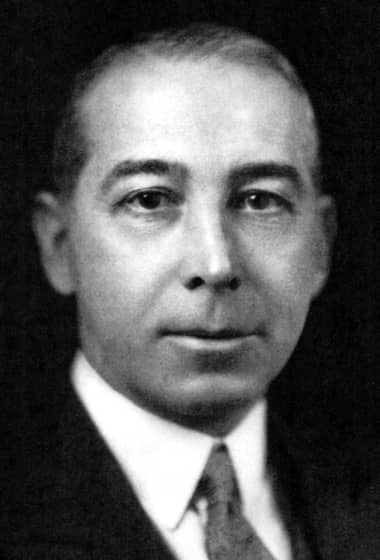
Northam Warren [1878-1962] aged around 50.
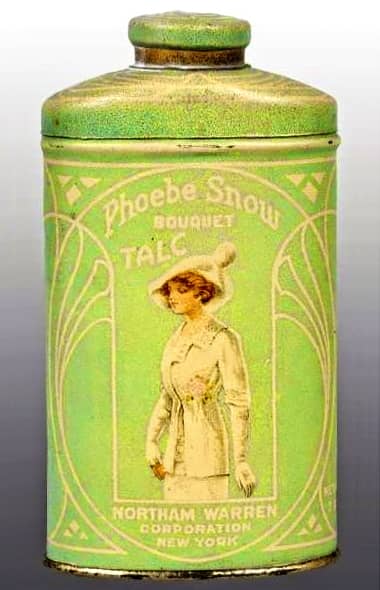
Phoebe Snow Talcum Powder.
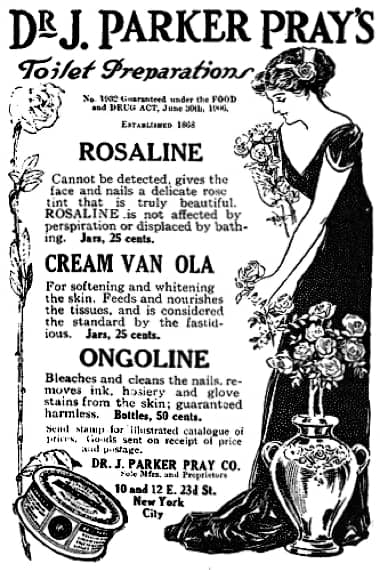
1912 Dr. J. Parker Pray.
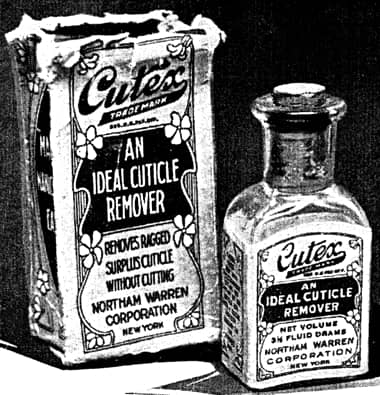
1919 Cutex Cuticle Remover. This may have been what the original packaging and bottle looked like. The bottle was bought in 1917 and returned to Northam Warren in 1919 after being taken to Europe during the First World War. By 1919, it had been replaced with a frosted bottle.
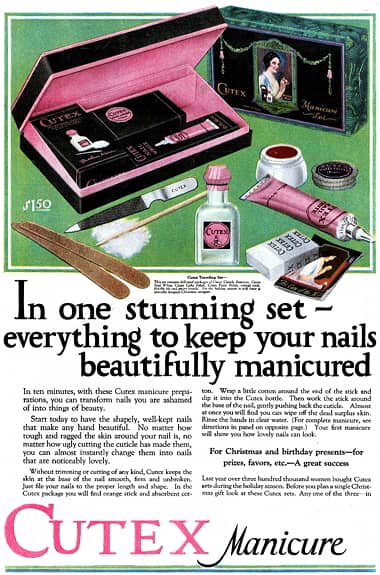
1920 Cutex Travelling Set after the packaging had been redesigned by the J. Walter Thompson advertising agency.
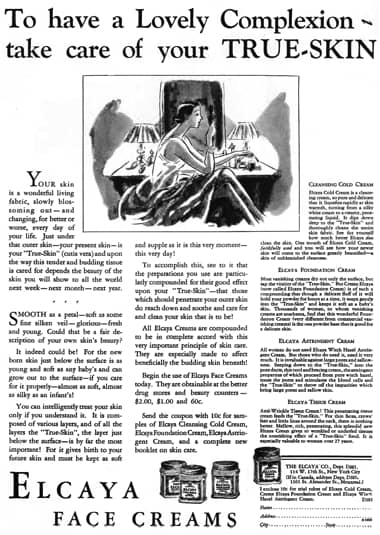
1928 Elcaya Face Creams.
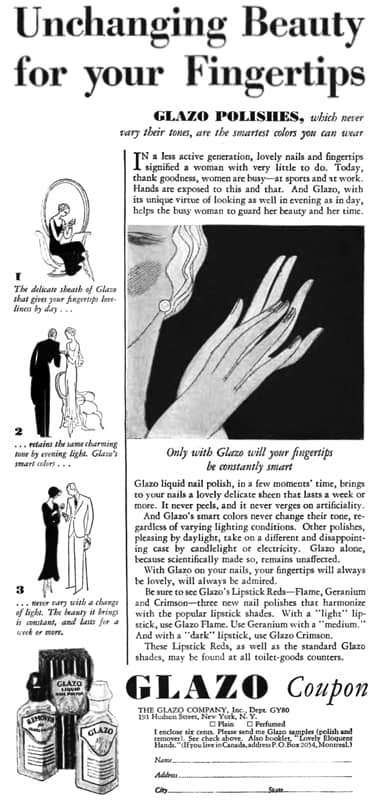
1930 Glazo Nail Polishes.
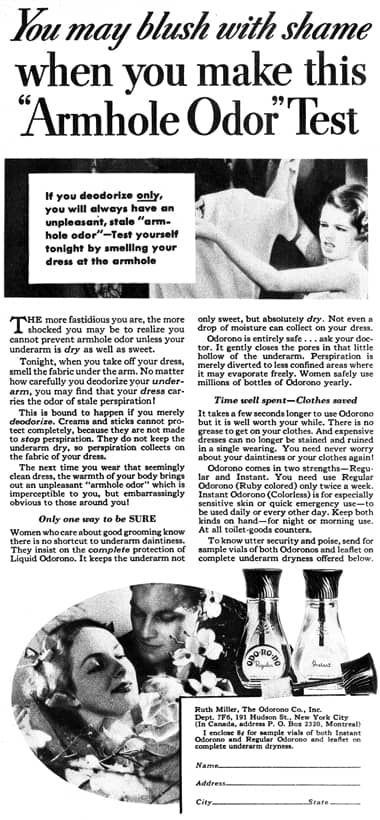
1936 Odorono.
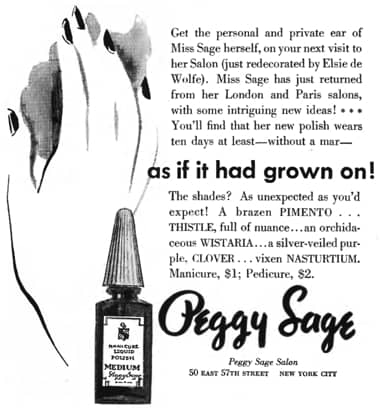
1937 Peggy Sage.
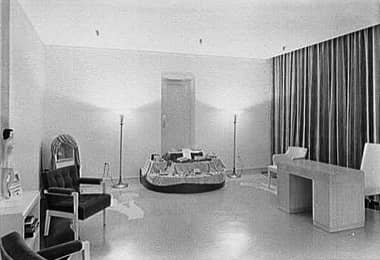
1940 Color Studio at the Stamford Plant.
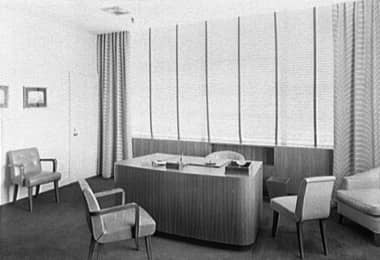
1940 Northam Warren’s office at the Stamford Plant.
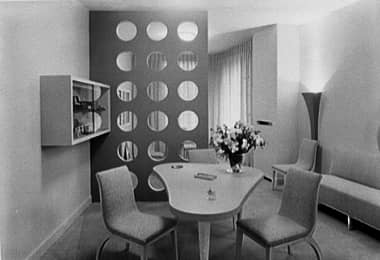
1940 Lobby at the Stamford Plant.
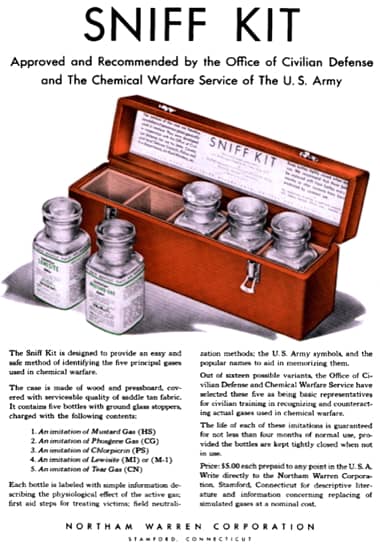
Sniff Kit.
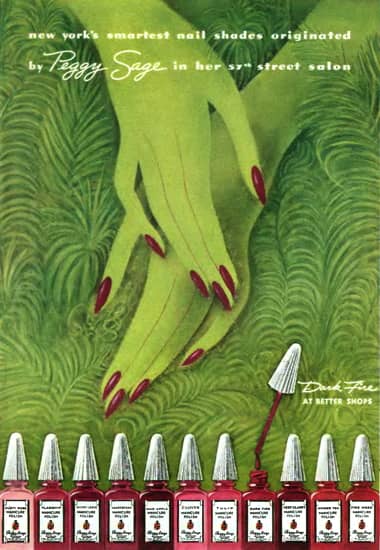
1943 Peggy Sage.
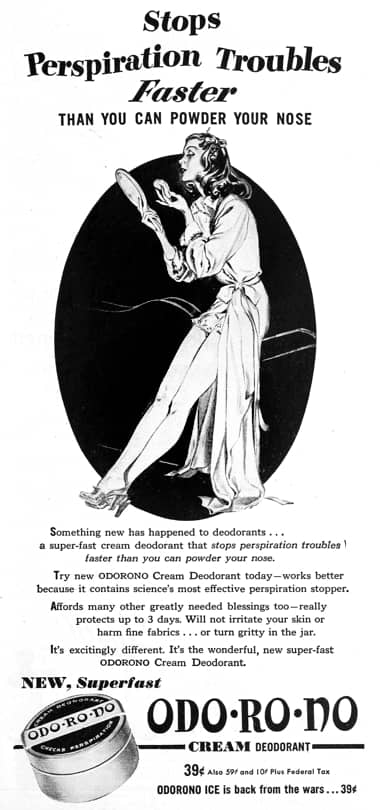
1946 Odorono Cream Deodorant.
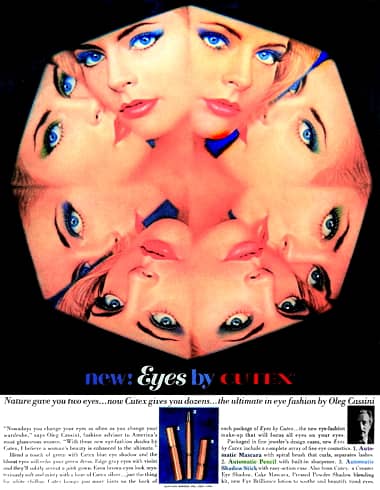
1962 Eyes by Cutex.
